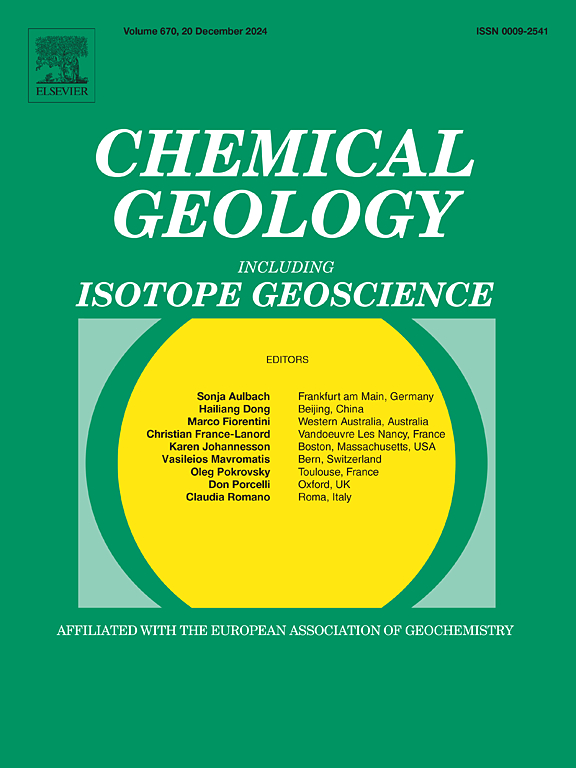沉积后对黑色页岩中铬的影响及其基于铬同位素的古氧化还原重建意义
IF 3.6
2区 地球科学
Q1 GEOCHEMISTRY & GEOPHYSICS
引用次数: 0
摘要
铬(Cr)是一种氧化还原敏感元素,其同位素系统已被广泛用作古氧化还原代理,为了解地球海洋和大气中氧的演化提供了见解。黑色页岩是沉积Cr同位素资料的重要档案。黑色页岩中Cr同位素记录的精确解释依赖于对黑色页岩形成和成岩过程中Cr地球化学行为的全面理解。本文采用同步辐射x射线光谱、顺序浸出、Cr同位素分析等方法,对不同地点、不同地质时期沉积黑色页岩中的Cr进行了研究。结果表明,大部分自生Cr(即海水中析出的Cr)不与通常的成氢相(如有机质或富铁组分)有关,而是存在于粘土矿物中。研究表明,沉积后成岩作用可诱导黑色页岩中自生Cr的再分配,导致硅酸盐矿物中自生Cr的富集。此外,这些过程还伴随着显著的Cr同位素分馏,从而显著改变了原始相的Cr同位素组成。类似的影响也会影响黑色页岩中的其他微量元素,如钒。研究结果表明,在黑色页岩中有效分离这些元素的自生和碎屑组分是不可能的。相反,在整体同位素分析后,使用典型碎屑示踪剂(如钛和铝)的浓度进行碎屑校正是一种更实用的方法。这一限制影响了高碎屑贡献黑色页岩同位素数据古环境解释的可靠性。本文章由计算机程序翻译,如有差异,请以英文原文为准。
Post-depositional effects on chromium in black shales and implications for paleo-redox reconstructions based on chromium isotopes
Chromium (Cr) is a redox-sensitive element, and its isotope system has been widely used as a paleo-redox proxy, providing insights into the evolution of oxygen in Earth's oceans and atmosphere. Black shales serve as an important archive for sedimentary Cr isotope data. The precise interpretation of Cr isotope records in black shales relies on a comprehensive understanding of the geochemical behavior of Cr throughout black shale formation and diagenesis. Here, we applied synchrotron-based X-ray spectroscopy, sequential leaching, and Cr isotope analysis to investigate the Cr species in sedimentary black shales from various sites and geologic periods. The results show that most of the authigenic Cr, which is the fraction of Cr precipitated from seawater, is not associated with the usual hydrogenetic phases (e.g., organic matter or iron-rich components) but rather resides in clay minerals. We further demonstrate that post-depositional diagenetic processes can induce redistribution of authigenic Cr in black shales, leading to enrichments of authigenic Cr in silicate minerals. Moreover, these processes were accompanied by significant Cr isotope fractionation, which substantially altered the Cr isotope compositions of the original phases. Similar effects can influence other trace elements, such as vanadium, in black shales. The findings imply that effectively separating authigenic and detrital fractions of these elements in black shales is unlikely. Instead, applying detrital corrections using the concentrations of typical detrital tracers (such as titanium and aluminum) after bulk isotope analysis is a more practical approach. This limitation affects the reliability of paleo-environmental interpretations derived from isotope data in black shales with high detrital contributions.
求助全文
通过发布文献求助,成功后即可免费获取论文全文。
去求助
来源期刊

Chemical Geology
地学-地球化学与地球物理
CiteScore
7.20
自引率
10.30%
发文量
374
审稿时长
3.6 months
期刊介绍:
Chemical Geology is an international journal that publishes original research papers on isotopic and elemental geochemistry, geochronology and cosmochemistry.
The Journal focuses on chemical processes in igneous, metamorphic, and sedimentary petrology, low- and high-temperature aqueous solutions, biogeochemistry, the environment and cosmochemistry.
Papers that are field, experimentally, or computationally based are appropriate if they are of broad international interest. The Journal generally does not publish papers that are primarily of regional or local interest, or which are primarily focused on remediation and applied geochemistry.
The Journal also welcomes innovative papers dealing with significant analytical advances that are of wide interest in the community and extend significantly beyond the scope of what would be included in the methods section of a standard research paper.
 求助内容:
求助内容: 应助结果提醒方式:
应助结果提醒方式:


